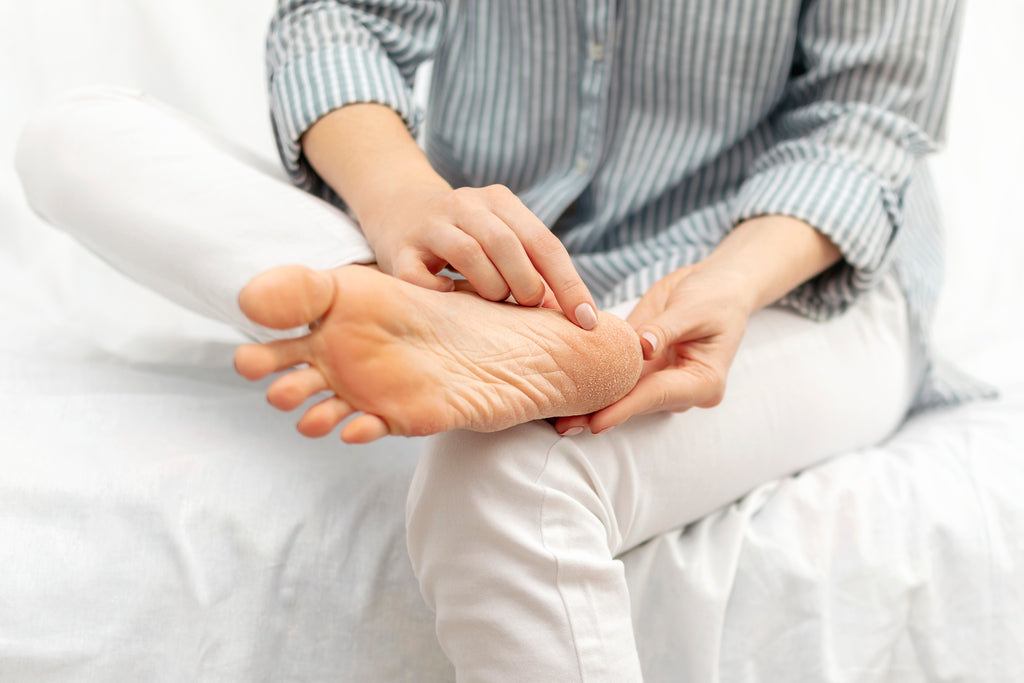
Imagine if every step you took felt like you were walking on burning coals. That is what it feels like when psoriasis on your feet flares up. The red, scaly lesions and dry cracked skin that occurs during a psoriasis flare makes it difficult to complete even the simplest of tasks such as act of putting on socks or sitting and relaxing.
Between the pain and unpredictability of when symptoms will flare up, it often feels like psoriasis takes over your life. While there is no cure for psoriasis, you can take control back of your life just by making a few lifestyle changes and using natural remedies.
Take the first step to learning how to control your psoriasis by continuing to read our blog. We provide helpful tips and advice on various natural remedies and lifestyle changes that – if followed – could have a positive impact on your psoriasis symptoms.
What Happens When Psoriasis Affects the Feet?
Skin cell growth follows a cycle. Newer, healthier skin cells grow while older, drier skin cells flake off. This skin cell growth process occurs multiples times a day all over your body and you probably don’t even notice it unless you suffer from psoriasis.
Psoriasis is a skin condition that causes the immune system to overreact which results in abnormal skin cell growth. Though we aren’t sure exactly why this happens, we do know that exposure to certain triggers, such as extreme stress, hormonal changes, or injuries, can cause the immune system to become overactive.
With psoriasis, the body is unable to keep up with the accelerated skin growth caused by an overactive immune system. The skin cells grow at such a rapid rate that they start to build up along the surface of the skin which causes scales and thick plaques to form.
Foot psoriasis is sometimes referred to as palmoplantar psoriasis. Common symptoms of palmoplantar psoriasis on the feet include:
- *Silvery-white flakes or scales
- *Formation of thick patches of skin known as plaques
- *Extreme itching
- *Dryness
- *Redness and inflammation
- *Cracked skin which can cause pain or bleeding
Symptoms of palmoplantar psoriasis typically occur on the soles of the foot. However, symptoms of palmoplantar psoriasis can appear on any part of the foot including the toes, nails, and heels.
Palmoplantar Pustulosis (PPP)
According to the National Psoriasis Foundation, palmoplantar pustulosis (PPP) psoriasis is experienced by at least 40% of people with psoriasis.
People who have foot psoriasis are at risk of developing a more painful, comfortable type of psoriasis known as palmoplantar pustulosis (PPP). With palmoplantar pustulosis, tiny brown fluid-filled stubs, called pustules, form a top the red, scaly skin lesions. Over time, the pustules will dry out and eventually peel off the skin. This is extremely painful as cracks, also known as fissures, form in the skin.
Palmoplantar pustulosis commonly develops on skin that is regularly disturbed and stretched, such as near the toes or heels.
Unique Challenges Caused by Psoriasis on the Feet

During a flare-up, symptoms of foot psoriasis can be so painful and uncomfortable that you are unable to walk. This presents unique challenges that make completing daily tasks difficult. Additionally, problems with mobility can cause you to experience extreme stress, anxiety, and depression.
Top 6 Home Remedies to Manage and Treat Foot Psoriasis
Foot psoriasis is something you will have to deal with for the rest of your life. However, you can improve your quality of life by finding a home remedy – or a combination of home remedies - that not only treat psoriasis symptoms, but also works to reduce flares on your feet.
Avoid Wearing Open-Toe Shoes or Sandals
Injuries are one of the most common triggers for a psoriasis flare up. When you wear open-toe shoes or sandals, you are at risk of injuring your foot. Keep your feet protected by choosing to wear shoes that cover every part of your foot from the toes to the heels.
You will also want to avoid wearing ill-fitting, tight shoes or high heels. The pressure placed on your feet when you wear these types of shoes can cause your foot psoriasis to flare up.
If you do happen to injure your foot, make sure you immediately treat the injury. Quickly treating your injury could reduce your risk of experiencing psoriasis flare-ups.
Combine Diet with Exercise
According to a study published by Frontiers in Immunology, people who were overweight or obese experienced psoriasis symptoms that were more painful and intense than those who were of a healthy weight. Combining diet with exercise will not only make you feel better, but it also helps with your quest to improve your psoriasis symptoms.
Some changes that you can make to your lifestyle or diet that will help with your foot psoriasis include:
- *Exercise for at least 30 minutes a day
- *Limit consumption of alcohol and sugary foods/drinks
- *Eat a healthy diet filled with fruits and vegetables that are high in antioxidants – leafy greens, nuts, olive oils, seeds, sardines, salmon, berries, and cherries
- *Consider trying a gluten-free diet
Moisturize Frequently – Day and Night
Frequent moisturizing with a fragrance-free product like Prosoria Rapid Repair Skin Exfoliating and Moisturizing Ointment helps with treatment and prevention of psoriasis flare-ups.
With daily use of Prosoria Rapid Repair, your skin will feel softer, smoother, and healthier. During a psoriasis flare-up, this ointment exfoliates and sloughs off dead skin cells on the feet which improves their appearance while intensely moisturizing and hydrating.
Avoid Long Hot Baths or Showers
Soaking in the tub or standing in shower can certainly be relaxing, but it can be a trigger for your psoriasis symptoms. Limiting your showers and baths to no more than 15 minutes can reduce your risk of experiencing painful, uncomfortable foot psoriasis symptoms.
The temperature of the water can also make a difference. Make sure the water you are using is warm, not hot.
Care for Your Feet on a Daily Basis
When creating a skincare routine, you often focus on other, more visible parts of your body such as your hands, elbows, and knees, but your feet are just as important. Consistently caring for the skin on your feet on a daily basis will reduce your flare-ups.
Prosoria is great for people who want to start a consistent skincare regimen. It is a 2-step psoriasis treatment system that only needs to be used once a day. The best part of using this system is that it only takes a few minutes. Just set aside 5 to 15 minutes a day and over time you will be able to see improvements to your psoriasis symptoms and even notice a decrease in reoccurrence of flare-ups.
Boost Your Immune System with a Daily Turmeric Supplement
The stronger your immune system is, the harder it can fight when you are exposed to foot psoriasis triggers. Daily turmeric supplements, like Nuvothera, safely and naturally give your immune system a boost so it is prepared to fight inflammation that causes psoriasis.
If you do happen to suffer from a foot psoriasis flare-up, your boosted immune system from Nuvothera can help speed up the recovery process. The faster you recover, the less pain and discomfort you experience.
A cure doesn’t exist for foot psoriasis, but that doesn’t mean you have to let it run your life. Use these natural remedies to make small improvements to your life and soon you will be in charge – not your psoriasis. In addition, there are over the counter treatments that can be helpful. Prosoria psoriasis treatment system is effective in treating foot and body psoriasis. The treatment system contains treatment gel and exfoliating moisturizer.
Curious to learn more about how Nuvothera and Prosoria help those who suffer from foot psoriasis? Click here to learn more about these essential natural remedies that not only help treat foot psoriasis, but reduce flares from occurring on your feet.

